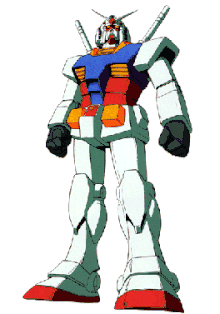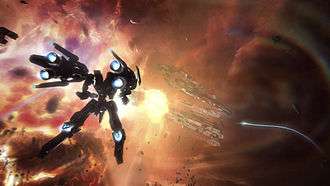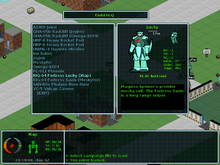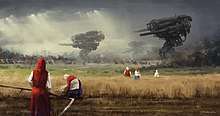Mecha
The term mecha (Japanese: メカ, Hepburn: meka) may refer to both scientific ideas and science fiction genres that center on giant robots or machines (mechs) controlled by people. Mechas are typically depicted as humanoid mobile robots. The term was first used in Japanese (meka) after shortening the English loanword mekanikaru ('mechanical'), but the meaning in Japanese is more inclusive, and "robot" (robotto) or "giant robot" is the narrower term.
These machines vary greatly in size and shape, but are distinguished from vehicles by their humanoid or biomorphic appearance and size—bigger than a human. Different subgenres exist, with varying connotations of realism. The concept of Super Robot and Real Robot are two such examples found in Japanese anime and manga. The term may also refer to real world piloted humanoid or non-humanoid robotic platforms, either currently in existence or still on the drawing board (i.e. at the planning or design stage). Alternatively, in the original Japanese context of the word, "mecha" may refer to mobile machinery/vehicles (including aircraft) in general, manned or otherwise.
Characteristics
The word "mecha" (メカ, meka) is an abbreviation, first used in Japanese, of the word "mechanical". In Japanese, mecha encompasses all mechanical objects, including cars, guns, computers, and other devices, and the term "robot" (ロボット, robotto) or "giant robot" is used to distinguish limbed vehicles from other mechanical devices. Outside of this usage, it has become associated with large humanoid machines with limbs or other biological characteristics. Mechas differ from robots in that they are piloted from a cockpit, typically located in the chest or head of the mech.[1]
While the distinction is often hazy, mecha typically does not refer to form-fitting powered armor such as Iron Man's suit. They are usually much larger than the wearer, like Iron Man's enemy the Iron Monger, or the mobile suits depicted in the Gundam series.
In most cases, mecha are depicted as fighting machines, whose appeal comes from the combination of potent weaponry with a more stylish combat technique than a mere vehicle. Often, they are the primary means of combat, with conflicts sometimes being decided through gladiatorial matches. Other works represent mecha as one component of an integrated military force, supported by and fighting alongside tanks, fighter aircraft, and infantry, functioning as a mechanical cavalry. The applications often highlight the theoretical usefulness of such a device, combining a tank's resilience and firepower with infantry's ability to cross unstable terrain and a high degree of customization. In some continuities, special scenarios are constructed to make mecha more viable than current-day status. For example, in Gundam the fictional Minovsky particle inhibits the use of radar, making long-range ballistic strikes impractical, thus favouring relatively close range warfare of Mobile Suits.
However, some stories, such as the manga/anime series Patlabor and the American wargame BattleTech universe, also encompass mecha used for civilian purposes such as heavy construction work, police functions or firefighting. Mecha also see roles as transporters, recreation, advanced hazmat suits and other R and D applications.
Mecha have been used in fantasy settings, for example in the anime series Aura Battler Dunbine, The Vision of Escaflowne, Panzer World Galient and Maze. In those cases, the mecha designs are usually based on some alternative or "lost" science-fiction technology from ancient times. In case of anime series Zoids, the machines resemble dinosaurs and animals, and have been shown to evolve from native metallic organisms.
A chicken walker is a fictional type of bipedal robot or mecha, distinguished by its rear-facing knee joint. This type of articulation resembles a bird's legs, hence the name.[2] However, birds actually have forward-facing knees; they are digitigrade, and what most call the "knee" is actually the ankle.[3]
Early history
The 1868 Edward S. Ellis novel The Steam Man of the Prairies featured a steam-powered, back piloted, mechanical man. The 1880 Jules Verne novel La Maison à vapeur (The Steam House) featured a steam-powered, piloted, mechanical elephant. One of the first appearances of such machines in modern literature was the tripod or fighting machine of H. G. Wells' famous The War of the Worlds (1897). The novel does not contain a fully detailed description of the tripods' (or "fighting-machine", as they are known in the novel) mode of locomotion, however it is hinted at: "Can you imagine a milking stool tilted and bowled violently along the ground? That was the impression those instant flashes gave. But instead of a milking stool imagine it a great body of machinery on a tripod stand."
Ōgon Bat, a kamishibai that debuted in 1931 (later adapted into an anime in 1967), featured the first piloted humanoid giant robot, Dai Ningen Tanku (大人間タンク),[4] but as an enemy rather than a protagonist. The first humanoid giant robot piloted by the protagonist appeared in the manga Atomic Power Android (原子力人造人間, Genshiryoku Jinzō Ningen) in 1948.[5] The manga and anime Tetsujin 28-Go, introduced in 1956, featured a robot, Tetsujin, that was controlled externally by an operator via remote control. The manga and anime Astro Boy, introduced in 1952, with its humanoid robot protagonist, was a key influence on the development of the giant robot genre in Japan. The first anime featuring a giant mecha being piloted by the protagonist from within a cockpit was the Super Robot show Mazinger Z, written by Go Nagai and introduced in 1972.[6] Mazinger Z introduced the notion of mecha as pilotable war machines, rather than remote-controlled robots. Nagai later introduced the concept of gattai ("combination"), where several modules slot together to form a super robot, with Getter Robot (1974 debut).[7]
An early use of mech-like machines outside Japan is found in "The Invisible Empire", a "Federal Men" comic by Jerry Siegel and Joe Shuster (serialized 1936 in New Comics #8-10). Other examples include the Brazilian comic "Audaz, the demolisher", by Álvaro "Aruom" Moura and Manoel Messias (1939), Kimball Kinnison's battle suit in E. E. "Doc" Smith's Lensman novel Galactic Patrol (1950), the French animated film The King and the Mockingbird (first released 1952), and Robert Heinlein's waldo in his 1942 short story, "Waldo" and the Mobile Infantry battle suits in Robert Heinlein's Starship Troopers (1958).
A transforming mech can transform between a standard vehicle (such as a fighter plane or transport truck) and a fighting mecha robot. This concept of transforming mecha was pioneered by Japanese mecha designer Shōji Kawamori in the early 1980s, when he created the Diaclone toy line in 1980 and then the Macross anime franchise in 1982. In North America, the Macross franchise was adapted into the Robotech franchise in 1985, and then the Diaclone toy line was adapted into the Transformers franchise in 1986. Some of Kawamori's most iconic transforming mecha designs include the VF-1 Valkyrie from the Macross and Robotech franchises, and Optimus Prime (called Convoy in Japan) from the Transformers and Diaclone franchises.[8][9]
Genres
Anime and manga

In Japan, "robot anime" (known as "mecha anime" outside Japan) is one of the oldest genres in anime.[10] Robot anime is often tied in with toy manufacturers. Large franchises such as Gundam, Macross, Transformers and Zoids have hundreds of different model kits.
The size of mecha can vary according to the story and concepts involved. Some of them may not be considerably taller than a tank (Armored Trooper Votoms, Megazone 23, Code Geass), some may be a few stories tall (Gundam, Escaflowne, Bismark, Gurren Lagann), others can be as tall as a skyscraper (Space Runaway Ideon, Genesis of Aquarion, Neon Genesis Evangelion), some are big enough to contain an entire city (Macross), some the size of a planet (Diebuster), galaxies (Getter Robo, Tengen Toppa Gurren Lagann), or even as large as universes (Tengen Toppa Gurren Lagann: Lagann-hen, Demonbane).
The first giant robots seen were in the 1948 manga Atomic Power Android (原子力人造人間, Genshiryoku Jinzō Ningen)[5] and Mitsuteru Yokoyama's 1956 manga Tetsujin 28-go. However, it wasn't until the advent of Go Nagai's Mazinger Z that the genre was established. Mazinger Z innovated by adding the inclusion of futuristic weapons, and the concept of being able to pilot from a cockpit[6] (rather than via remote control, in the case of Tetsujin). According to Go Nagai:
I wanted to create something different, and I thought it would be interesting to have a robot that you could drive, like a car.[6]
Mazinger Z featured giant robots which were "piloted by means of a small flying car and command center that docked inside the head."[6] It was also a pioneer in die-cast metal toys such as the Chogokin series in Japan and the Shogun Warriors in the U.S., that were (and still are) very popular with children and collectors.
Robot/mecha anime and manga differ vastly in storytelling and animation quality from title to title, and content ranges all the way from children's shows to ones intended for an older teen or adult audience.
Some of the first mecha featured in manga and anime were super robots. The super robot genre features superhero-like giant robots that are often one-of-a-kind and the product of an ancient civilization, aliens or a mad genius. These robots are usually piloted by Japanese teenagers via voice command or neural uplink, and are often powered by mystical or exotic energy sources.[11]
The later real robot genre features robots that do not have mythical superpowers, but rather use largely conventional, albeit futuristic weapons and power sources, and are often mass-produced on a large scale for use in wars.[11] The real robot genre also tends to feature more complex characters with moral conflicts and personal problems.[12] The genre is therefore aimed primarily at young adults instead of children.[13] Mobile Suit Gundam (1979) is largely considered the first series to introduce the real robot concept and, along with The Super Dimension Fortress Macross (1982), would form the basis of what people would later call real robot anime.[14]
Some robot mecha are capable of transformation (Macross and Zeta Gundam) or combining to form even bigger ones (Beast King GoLion and Tengen Toppa Gurren Lagann), the latter called gattai. Go Nagai is often credited with inventing this in 1974 with the television series Getter Robo.
Not all mecha need to be completely mechanical. Some have biological components with which to interface with their pilots, and some are partially biological themselves, such as in Neon Genesis Evangelion, Eureka Seven, and Zoids.
Mecha based on anime have seen extreme cultural reception across the world. The personification of this popularity can be seen as 1:1 size Mazinger Z, Tetsujin, and Gundam statues built across the world.
Film
- The Star Wars multimedia franchise features several walker types, such as the world-famous AT-AT and AT-ST.
- The film Robot Jox is based around gladiatorial combat between giant mecha.
- In the 1986 film Aliens, Ripley uses a Caterpillar P-5000 Work Loader to fight the alien Queen.
- Sentinel 2099, a 1995 film, features a 40 foot tall walking tank called a Sentinel unit. They are used to combat an alien race known as the Zisk.
- In the 1999 film Wild Wild West, Dr. Loveless attempts to use an 8 story tall, steam-powered, walking spider to conquer a post-Civil War United States.
- In The Matrix Revolutions, Captain Mifune leads the human defense of Zion, piloting open-cockpit mecha called APUs, against invading Sentinels.
- In James Cameron's 2009 film Avatar, mecha called amplified mobility platform. The AMPs are used as instruments of war.
- In Shane Acker's 2009 animated film 9, giant walking war machines called Steel Behemoths were created by the Fabrication Machine to destroy all life on Earth.
- A heavily weaponized powered exoskeleton that envelops the operator is featured in the 2009 film District 9, and aptly named the Exo-suit.
- Guillermo del Toro's 2013 film Pacific Rim focuses on a war between humans who pilot massive mechas known as Jaegers and Kaiju monsters that emerge from the Pacific Ocean.
- In The Amazing Spider-Man 2, the Rhino uses a one-person mecha suit that possesses super strength and defense.
- In the film Iron Man, the Iron Monger, a powered exoskeleton suit operated by Obadiah Stane, is another example of mecha.
- In the final scenes of The Lego Movie, the main protagonist Emmet creates a giant construction mech made of yellow Lego pieces which he pilots to fight in the final battle against Lord Business' forces.
- In Avengers: Age of Ultron Iron Man uses a mecha named the Hulkbuster to fight the Hulk.
- In the 2001 film AI: Artificial Intelligence by Steven Spielberg, the term mecha refers to an advanced humanoid robot species featured in the film.
Video games


Mecha are often featured in computer and console video games. Because of their size and fictional power, mecha are quite popular subjects for games, both tabletop and electronic. They have been featured in video games since the 1980s, particularly in vehicular combat and shooter games, including Sesame Japan's side-scrolling shooter game Vastar in 1983,[15] various Gundam games such as Mobile Suit Gundam: Last Shooting in 1984 and Z-Gundam: Hot Scramble in 1986,[16] the run and gun shooters Hover Attack in 1984 and Thexder in 1985, and Arsys Software's 3D role-playing shooters WiBArm in 1986 and Star Cruiser in 1988. Historically mecha-based games have been more popular in Japan than in other countries.[17]
- Metal Gear series (1987 – ) by Hideo Kojima, includes mecha as part of its main premise. The series takes place during the modern day and near future, and the prototype nuclear-capable bipedal tanks called Metal Gears are a recurring element.
- A popular classic of mecha in games is the MechWarrior series (1989 – ) of video games, which takes place in the Battletech universe.
- Intelligent Systems-developed and Nintendo-published games that feature mecha include Battle Clash (1992) and Metal Combat: Falcon's Revenge (1993), a single-player mecha-themed shooter series with real robot-style. All battles are fought with mechas called Standing Tanks (ST).
- Squaresoft-developed games that feature mecha include Front Mission (1995 – ), a turn-based tactical series of games with real robot-style mecha utilized by near future military forces. Xenogears (1998) also used mecha, called Gears, as a main aspect of the story, and the series continues the use of mecha with the Monolith Soft-developed Xenoblade Chronicles series (2010 – ).
- Armored Core (1997 – ) is a mecha series developed by FromSoftware, combining industrial customizable mecha designs with fast-paced action.
- In StarCraft series (1998 – ), the goliath combat walker is one of the most recognizable Terran units.
- The Monolith Productions game Shogo: Mobile Armor Division (1998) blended mecha gameplay with that of traditional first-person shooter games.[18]
- Heavy Gear 2 (1999) offers a complex yet semi-realistic control system for its mecha in both terrain and outer space warfare.
- In Zone of the Enders (2001 – ) by Hideo Kojima, real robots called LEVs exist alongside a more super robot-like mecha type known as the Orbital Frame.
- In Battlefield 2142 (2006), mecha fight alongside conventional military units such as infantry, tanks, gunships, and APCs in the European Union's and Pan-Asian Coalition's military forces.
- In Supreme Commander (2007), all 3 factions utilize mechs, be they tanks, gunships, or true mechs. The player's Armored Command Unit is one such mech.
- Various units in Command & Conquer 3: Tiberium Wars (2007) and its expansion (2008) are walkers, with the most noticeable being Juggernaut, Titan Mk. II, and Wolverine Mk. II from the GDI faction, and the Avatar from the Brotherhood of Nod.
- League of Legends (2009), developed by Riot Games, include mecha as part of champion skins, designed as super robots (Mecha Malphite, Mecha Kha Zix, Mecha Aatrox, Mecha Zero Sion, etc.).
- Hawken (2012) is an online first person shooter in which pilots can choose from a variety of bipedal mechas, each having an intended specialization, to engage in free-for-all or team-based combat. Mechas have special abilities related to their role that, when activated, augment their weapon cooling, damage, defense, accuracy, mobility, stealth, or other characteristic to provide a temporary advantage.
- War Thunder (2012) during an April Fools event, players were able to control Mecha tanks that consisted of multiple tank turrets and other parts after destroying a certain number of vehicles in a battle.
- In Titanfall (2014) and Titanfall 2 (2016) from Respawn Entertainment, mechas are heavily involved within gameplay and the story.[19]
- In Heroes of the Storm (2015), developed by Blizzard Entertainment, players can take control of the giant mecha, called "Triglav Protector", as a reward for winning objective on Volskaya Foundry battleground. The mecha is co-piloted by two different players, the first serving as a pilot, and the second serving as a gunner. Each player is given control to a different set of unique abilities.[20] In January 2018 and June 2019, Blizzard created two "MechaStorm" events for Heroes of the Storm, featuring multiple mecha skins for a number of heroes, as well as other items for the Collection.[21][22] A MechaStorm "anime video trailer" was also released, heavily inspired by series such as Mobile Suit Gundam, and Neon Genesis Evangelion.
- Overwatch (2016), team shooter from Blizzard Entertainment, includes D.Va, a tank hero who pilots a mecha. Stylized as MEKA (Mobile Exo-Force of the Korean Army), D.Va's mecha provides her primary hero abilities as well as being a driver of her backstory in the game's lore.[23] Wrecking Ball is a tank-class quadrupedal mecha robot driven by a genetically engineered hamster named Hammond. The mecha is armed with automatic assault weapons known as the "quad cannons", and can be transformed into a high-speed "wrecking ball" equipped with a grappling hook.[24]
- Kirby: Planet Robobot (2016) features extensive use of mecha suit known as the Robobot Armor to solve puzzles and fight enemies. Mecha resembling Kirby with the ability to copy enemy abilities (known as Modes).
Tabletop games

- In the tabletop game Warhammer 40,000, the forces use mecha of a variety of sizes and shapes.
- Older American Tabletop games, Battletech, uses hex-maps, miniatures & paper record sheets that allow players to use mecha in tactical situations and record realistic damage, while add RPG elements when desired.
Real mecha
There are a few real prototypes of mecha-like vehicles. Currently almost all of these are highly specialized or just for concept purpose, and as such may not see mass production.
- Land Walker: A machine developed by Sakakibara Kikai with the intention of giving the impression of a bipedal mecha.[25][26]
- In 2018, Japanese engineer Masaaki Nagumo from Sakakibara Kikai completed construction of a functional bipedal mecha inspired by the Gundam franchise. The device, standing 8.5 meters tall and weighing about 7 tonnes, possesses fully functional arm and leg servos.[27]
In the Western world, there are few examples of mecha, however, several machines have been constructed by both companies and private figures. Timberjack, a subsidiary of John Deere, built a practical hexapod walking harvester.[28]
References
- "Mech (Object) - Giant Bomb". Giant Bomb. Archived from the original on 2018-10-03. Retrieved 2018-10-03.
- Slavicsek, Bill (2000). A Guide to the Star Wars Universe: Third Edition. Del Rey and Lucas Books. pp. 14. ISBN 0-345-42066-7.
- Kochan, Jack (1994). Feet & Legs. Stackpole Books. ISBN 0-8117-2515-4.
- Dai Ningen Tanku (大人間タンク) means Giant Ningen Tanku (人間タンク) , Ningen Tanku (人間タンク) is the Japanese title of The Master Mystery(1919), and the Japanese name of the Powered exoskeleton appearing in the film."人間タンク : 奇蹟の人". NDL Digital Collections. Archived from the original on 2018-06-29. Retrieved 2018-06-29.It was a general Japanese phrase meaning "humanoid tank" too."日本ロボット戦争記 1939~1945". Archived from the original on 2018-07-02. Retrieved 2018-07-02.
- "原子力人造人間". NDL Digital Collections. Archived from the original on 2018-03-25. Retrieved 2018-03-23.
- Gilson, Mark (1998). "A Brief History of Japanese Robophilia". Leonardo. 31 (5): 367–369. doi:10.2307/1576597. JSTOR 1576597.
- Clements, Jonathan (2017). Anime: A History. Bloomsbury Publishing. pp. 150–1. ISBN 978-1-84457-884-9.
- Barder, Ollie (December 10, 2015). "Shoji Kawamori, The Creator Hollywood Copies But Never Credits". Forbes. Retrieved 16 April 2020.
- Knott, Kylie (27 February 2019). "He created Macross and designed Transformers toys: Japanese anime legend Shoji Kawamori". South China Morning Post. Retrieved 16 April 2020.
- "Archived copy". Archived from the original on 2004-05-29. Retrieved 2004-05-29.CS1 maint: archived copy as title (link)
- Hornyak, Timothy N. (2006). "Chapter 4". Loving the Machine: the Art and Science of Japanese Robots (1st ed.). Tokyo: Kodansha International. pp. 57–70. ISBN 4770030126. OCLC 63472559.
- Tomino, Yoshiyuki (2012). Mobile Suit Gundam: Awakening, Escalation, Confrontation. Schodt, Frederik L., 1950– (2nd ed.). Berkeley, CA: Stone Bridge Press. p. 8. ISBN 978-1611720051. OCLC 772711844.
- Denison, Rayna (2015). "Chapter 5". Anime: a Critical Introduction. London. ISBN 978-1472576767. OCLC 879600213.
- 10 commandments of Real robot, Gundam Sentinel introduction, Gundam workshop, Format ACG
- Vastar at the Killer List of Videogames
- Savorelli, Carlos (October 6, 2017). "Kidō Senshi Z-Gundam: Hot Scramble". Hardcore Gaming 101. Archived from the original on November 16, 2017. Retrieved November 15, 2017.
- "Iron Rain". Next Generation. No. 17. Imagine Media. May 1996. p. 86.
- Sabbagh, Michel (December 17, 2015). "Effort Upon Effort: Japanese Influences in Western First-Person Shooters" (PDF). Worcester Polytechnic Institute. Archived from the original (PDF) on January 1, 2016. Retrieved December 29, 2015.
- Arts, Electronic (2017-03-22). "Titanfall 2". ea.com. Archived from the original on 2017-07-23. Retrieved 2017-07-20.
- Lee, Sam (2017-09-15). "Heroes of the Storm: Introducing Assault on Volskaya Foundry Battleground". Medium. Retrieved 2019-09-26.
- Lee, Sam (2018-01-16). "Heroes of the Storm: New MechaStorm Skins and Animation". Medium. Retrieved 2019-09-26.
- Chen, Amy (2019-06-19). "Heroes of the Storm: MechaStorm II now live with exciting new quest chain". Daily Esports. Retrieved 2019-09-26.
- "D.Va - Heroes- Overwatch". Archived from the original on May 23, 2016. Retrieved April 1, 2019.
- Marshall, Cass (2018-06-28). "Overwatch's next hero is a chubby hamster and I love it". Polygon. Retrieved 2019-10-22.
- "Sakakibara-Kikai website". Sakakibara-Kikai (in Japanese). Sakakibara Machinery Co., Ltd. Archived from the original on December 1, 2017. Retrieved November 19, 2017.
- kiyomasa (April 7, 2006). "LAND WALKER -Japanese Robot suit-". YouTube. Archived from the original on December 4, 2017. Retrieved November 19, 2017.
- "Japanese engineer builds giant robot to realise 'Gundam' dream". Straits Times. April 13, 2018. Archived from the original on April 14, 2018. Retrieved April 14, 2018.
- beej69 (October 17, 2006). "Timberjack Walking Machine". YouTube. Archived from the original on December 22, 2017. Retrieved November 15, 2017.
External links
- Mecha Anime HQ: Extensive coverage on Gundams and other mecha.
- Mecha Co.
- Japanese Animation Guide: The History of Robot Anime